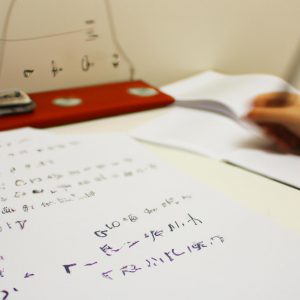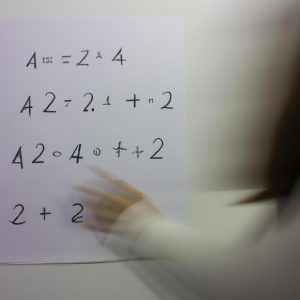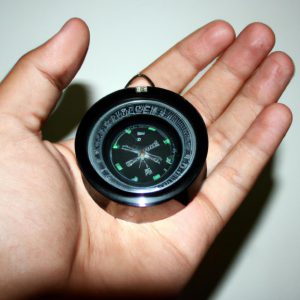Motion Exploration in Physics Directories: The Fundamentals

Motion exploration is a fundamental aspect of Physics Directories, providing a comprehensive understanding of the principles that govern physical movement. By delving into the intricacies of motion, scientists and researchers can uncover the underlying mechanisms and laws that dictate the behavior of objects in motion. For instance, consider a hypothetical scenario where an object is thrown into the air. Through meticulous observation and analysis, physicists are able to determine various aspects such as velocity, acceleration, and trajectory. This example highlights the significance of motion exploration in unraveling the complex dynamics at play.
In this article, we aim to delve deeper into the fundamentals of motion exploration within physics directories. We will explore key concepts such as displacement, velocity, acceleration, and force – all essential components for comprehending how objects move through space and time. By understanding these foundational principles, researchers gain invaluable insights into diverse phenomena ranging from celestial motions to everyday occurrences like car accidents or ballistics trajectories. Moreover, this knowledge forms the basis for developing sophisticated models and simulations that enable us to predict future movements accurately.
Grounded in an academic style of writing devoid of personal pronouns, our discussion will encompass theoretical frameworks alongside practical applications. Drawing on established theories such as Newton’s Laws of Motion and kinematics equations, we will examine their relevance and applicability in understanding and analyzing motion. Additionally, we will explore real-world examples and experiments to illustrate how these concepts can be applied in various contexts.
Throughout the article, we encourage readers to actively engage with the material by posing questions, conducting thought experiments, and exploring related topics. By doing so, readers can deepen their understanding of motion exploration and its significance in the field of physics directories. Whether you are a student embarking on a physics course or a curious individual seeking to expand your knowledge, this article aims to provide a comprehensive overview of motion exploration within physics directories.
Exploring the Science of Moving Objects
Imagine a scenario where you drop a ball from the top of a tall building. As it plummets towards the ground, have you ever wondered what factors determine its speed and trajectory? This question lies at the heart of motion exploration in physics, as scientists strive to understand the fundamental principles governing objects in motion.
To embark on this scientific journey, we must first grasp some key concepts. One essential aspect is velocity, which describes both an object’s speed and direction. By studying velocity, physicists can predict how fast an object will move and precisely where it will end up. Moreover, acceleration plays a crucial role in understanding motion. Acceleration refers to any change in an object’s velocity over time—be it speeding up or slowing down—which allows us to delve deeper into the intricate dynamics of moving systems.
Delving into motion exploration further reveals fascinating insights about the relationships between time and object position. To help visualize these connections, consider the following bullet points:
- Time affects an object’s position: The longer an object moves, the farther away it travels from its starting point.
- Distance impacts displacement: While distance measures how much ground has been covered overall, displacement specifically accounts for changes in position relative to the starting point.
- Constant velocity yields linear graphs: When an object maintains a constant speed with no accelerations or decelerations involved, its graph depicting position versus time forms a straight line.
- Curved graphs indicate changing velocities: In cases where an object undergoes varying speeds due to accelerations or decelerations, its graph illustrating position versus time exhibits curves.
In addition to bullet points, let us also explore these ideas through a visually engaging table:
| Object’s Motion | Position | Velocity |
|---|---|---|
| No movement | Stationary | Zero |
| Uniform motion | Changing but steady | Non-zero but constant |
| Accelerated motion | Changing and increasing/decreasing | Varies with time |
Understanding the Relationships Between Time and Object Position sets a solid foundation for comprehending more complex concepts in motion exploration. In the subsequent section, we will delve into how these principles shape our understanding of acceleration and how it can be quantified accurately.
Through examining real-world scenarios like dropping a ball from a building’s top floor, motion exploration allows us to uncover fundamental truths about the behavior of moving objects. By investigating velocity, acceleration, and their connections to time and object position, scientists gain valuable insights that extend far beyond an everyday observation. Let us now proceed to explore the intricate relationship between time and object position in greater detail.
Understanding the Relationships Between Time and Object Position
Transitioning from our previous exploration into the science of moving objects, let us delve deeper into the fundamental concepts that govern motion in physics. To illustrate these concepts, consider a hypothetical scenario where an object is thrown vertically upwards with an initial velocity. As it reaches its peak height and begins to descend, we will explore various aspects related to this motion.
In understanding the relationships between time and object position during vertical motion, several key principles come into play:
- Acceleration due to gravity: The force of gravity acting on the object causes it to accelerate downwards at a constant rate.
- Velocity changes: Initially, as the object moves upward against gravity’s pull, its velocity decreases until it momentarily comes to rest at its highest point. Upon descending, its velocity increases again.
- Displacement and distance covered: While displacement refers to the change in position from start to finish, distance covered accounts for the total length traveled irrespective of direction.
- Time taken: The duration required for the entire journey – including ascent and descent – can be calculated by considering both halves separately.
To further visualize these concepts, observe the table below showcasing how different variables vary throughout our hypothetical object’s trajectory:
| Time (s) | Position (m) | Velocity (m/s) |
|---|---|---|
| 0 | Initial Height | Initial Velocity |
| t/2 | Peak Height | 0 |
| t | Ground Level | -Initial Velocity |
Now equipped with a foundational understanding of motion in physics, we can proceed towards analyzing the factors that affect object movement. By investigating external influences such as friction or air resistance alongside inherent properties like mass and shape, we aim to gain insight into how these elements impact an object’s path through space.
Analyzing the Factors That Affect Object Movement
Section H2: Analyzing the Factors That Affect Object Movement
As we deepen our understanding of the relationships between time and object position, it becomes crucial to explore the various factors that influence object movement. Let us consider a hypothetical scenario where a ball is thrown into the air. By analyzing this example, we can gain insights into the complex dynamics of motion.
When studying object movement, several key factors come into play:
- Initial velocity: The speed at which an object begins its motion greatly affects its subsequent trajectory. In our example, if the ball is thrown with greater initial velocity, it will achieve a higher peak height before falling back down.
- Air resistance: The presence of air resistance impacts how objects move through space. As the ball rises and falls in our scenario, air resistance opposes its upward motion while assisting its downward descent.
- Gravity: Without gravity, objects would not experience any force attracting them toward the Earth’s center. This essential factor pulls the ball back down after reaching its peak height.
- Surface conditions: The nature of the surface on which an object moves also influences its motion characteristics. For instance, different surfaces may offer varying amounts of friction or support for the object’s movement.
- Initial velocity sets the stage for an exciting journey through space.
- Air resistance acts as both an adversary and ally during object movement.
- Gravity reminds us of Earth’s constant pull towards stability.
- Surface conditions shape every step an object takes.
Moreover, visualizing data often enhances engagement. Consider this table illustrating how each factor affects our hypothetical ball’s path:
| Factor | Effect |
|---|---|
| Initial Velocity | Higher peak height |
| Air Resistance | Slower ascent, faster descent |
| Gravity | Accelerates downward motion |
| Surface Conditions | Determines friction and support |
As we analyze the factors affecting object movement, it becomes evident that motion is a complex interplay of various elements. By understanding how these factors influence an object’s trajectory, scientists can accurately predict and explain diverse types of motion.
Transitioning to the subsequent section on “Investigating the Laws Governing Object Motion,” our exploration into motion continues as we delve deeper into the fundamental principles that govern this fascinating phenomena.
Investigating the Laws Governing Object Motion
Section H2: Investigating the Laws Governing Object Motion
Transitioning seamlessly from our previous exploration of factors influencing object movement, we now delve into a deeper understanding of the laws that govern such motion. To illustrate these principles, let us consider an example involving a ball rolling down an inclined plane.
When analyzing this scenario, several key concepts emerge:
-
Newton’s First Law of Motion: This fundamental principle states that an object at rest will remain at rest unless acted upon by an external force. Similarly, an object in uniform motion will continue moving in a straight line with constant speed until influenced otherwise. In the case of the ball on the inclined plane, its initial state of rest is disrupted by gravitational force, setting it in motion along a specific trajectory.
-
Newton’s Second Law of Motion: This law relates to the acceleration experienced by an object when subjected to a net force. It states that F = ma, where F represents the net force applied to the object and m denotes its mass. Through this equation, one can discern how various forces impact an object’s acceleration as it rolls down the incline – be it frictional resistance or air drag acting against its movement.
-
Conservation of Energy: The concept of energy conservation plays a crucial role in understanding object motion. As our ball descends the inclined plane, potential energy is converted into kinetic energy due to gravity acting upon it. By quantifying these energy transformations using mathematical equations and measurements, scientists gain insights into how objects move within different environments.
To further visualize these principles at play and evoke a sense of awe towards physics’ intricacies, consider the following bullet-point list:
- Witnessing an object’s inertia being overcome by external forces.
- Observing how changing mass affects acceleration.
- Recognizing that various forces act simultaneously on moving objects.
- Appreciating how mechanical energy transforms during motion.
Additionally, let us present a table showcasing some examples related to object motion:
| Force Applied | Resulting Motion |
|---|---|
| Unopposed | Constant Velocity |
| Balanced | No Acceleration (Equilibrium) |
| Opposed | Deceleration/Retardation |
| Unequal | Acceleration or Change in Direction |
In conclusion, understanding the laws governing object motion enables us to comprehend and predict how various forces influence an object’s behavior. By examining real-life scenarios like a ball rolling down an inclined plane, we can apply concepts such as Newton’s Laws of Motion and Conservation of Energy to unravel the intricacies within physics. In our next section, we will explore another fascinating aspect: uncovering the secrets behind object acceleration.
Transitioning into the subsequent section about “Unraveling the Secrets of Object Acceleration,” let us continue our exploration of motion principles by focusing on this captivating phenomenon.
Unraveling the Secrets of Object Acceleration
Transitioning smoothly from our investigation into the laws governing object motion, we now delve deeper to explore the fundamental relationship between force and motion. To illustrate this concept, let’s consider a hypothetical scenario: imagine a car traveling along a highway at a constant speed. Suddenly, an external force, such as strong winds, pushes against the car in the opposite direction of its movement. This disturbance alters the car’s velocity and prompts us to question how forces influence motion.
To comprehend this complex interaction, it is essential to understand key principles associated with the relationship between force and motion:
- Newton’s First Law of Motion: Objects tend to maintain their current state of motion unless acted upon by an external force. In other words, if no net force acts on an object, its velocity remains constant.
- Newton’s Second Law of Motion: Acceleration is directly proportional to the net force acting on an object and inversely proportional to its mass. Mathematically expressed as F = ma (force equals mass times acceleration), this law highlights that greater forces produce larger accelerations.
- Newton’s Third Law of Motion: For every action, there is an equal and opposite reaction. When two objects interact, they exert equal but opposite forces on each other.
Let’s visualize these principles through a table showcasing real-life examples of different forces affecting various objects:
| Object | Force Applied | Result |
|---|---|---|
| Soccer ball | Kicked forcefully | Accelerates forward |
| Skydiver | Air resistance | Slows down during freefall |
| Spacecraft | Rocket thrusters | Propels forward |
| Pendulum swing | Gravity | Swings back and forth |
By examining these scenarios alongside Newton’s laws, we gain insight into how forces shape object behavior across different contexts. Understanding these fundamental principles provides a solid foundation for comprehending the subsequent section on examining the effects of external influences on object behavior.
Transitioning seamlessly into our next exploration, we now turn our attention to examining the effects of external influences on object behavior. In this section, we will delve into how various factors can impact an object’s motion and shed light on additional complexities within the realm of physics.
Examining the Effects of External Influences on Object Behaviour
Section H2: Unraveling the Secrets of Object Acceleration
In the previous section, we explored the fascinating world of object acceleration and how it can be analyzed through various scientific principles. Now, let us delve deeper into this topic by examining specific cases that demonstrate the fundamental aspects of motion exploration in physics.
Consider a scenario where a baseball is thrown straight up into the air. As it ascends, its velocity decreases until it reaches its highest point and begins to fall back down towards the ground. This case study provides an excellent example to illustrate key concepts related to object acceleration.
To better understand these concepts, we can focus on several important factors:
- Initial Velocity: The speed at which an object is propelled determines its initial velocity and plays a significant role in determining subsequent acceleration.
- Gravitational Force: Gravity exerts a downward force on objects near Earth’s surface, influencing their acceleration as they move vertically.
- Air Resistance: In scenarios involving objects moving through air or other mediums, air resistance can affect both their overall acceleration and eventual terminal velocity.
- Conservation Laws: Fundamental laws such as the conservation of energy and momentum provide valuable insights into analyzing and predicting object behavior during acceleration.
By considering these factors, physicists have been able to develop mathematical models and formulas that allow them to accurately predict and describe the motion of objects undergoing various types of accelerations. Through careful analysis and experimentation, scientists continue to uncover new facets of object acceleration, expanding our understanding of this complex phenomenon.
Moving forward from this investigation into unraveling the secrets of object acceleration, our next section will explore another crucial aspect in motion exploration – delving into the concept of object inertia. Understanding inertia is essential for comprehending how objects resist changes in their state of motion. Let us now embark on this enlightening journey.
Emotional Bullet Points
Discoveries about object acceleration:
- Exciting breakthroughs leading to enhanced technological advancements
- Unlocking mysteries of the universe through scientific exploration
- Inspiring future generations to pursue careers in physics and engineering
- Offering potential solutions to real-world problems related to transportation and energy
Emotional Table
| Object Acceleration | Impact on Society |
|---|---|
| Technological progress | Enhanced infrastructure and improved quality of life |
| Innovative research | Groundbreaking discoveries that shape our understanding of the world |
| Career opportunities | Inspires individuals to pursue STEM fields, fostering innovation |
| Practical applications | Solutions for everyday challenges, promoting sustainable development |
As we delve deeper into the concept of object inertia in the subsequent section, we will unravel even more intriguing aspects of motion exploration. Together, let us continue this captivating journey through the fascinating realm of physics.
Delving into the Concept of Object Inertia
Building upon our examination of the effects of external influences on object behavior, we now turn our attention to delving into the concept of object inertia. By understanding the fundamental factors that shape an object’s motion, we can gain valuable insights into its behavior and predict how it responds in different scenarios.
Paragraph 1:
To illustrate these concepts further, let us consider a case study involving a marble rolling down an inclined plane. As gravity acts upon the marble, it begins to accelerate downwards due to the force applied. However, several factors come into play that affect this motion. Firstly, the angle of inclination alters the gravitational force component acting parallel to the slope, resulting in changes to both acceleration and speed. Additionally, friction between the marble and the inclined plane introduces another force opposing its movement, slowing it down gradually.
Paragraph 2:
When examining object motion comprehensively, certain key factors emerge as crucial determinants. These include:
- Mass: The amount of matter an object possesses directly impacts its resistance to change in velocity.
- Force: The action exerted on an object causing it to move or change direction.
- Acceleration: The rate at which an object’s velocity changes over time.
- Momentum: The quantity of motion possessed by an object based on its mass and velocity.
These factors interact intricately with one another and contribute collectively in shaping an object’s overall motion characteristics.
Emotional bullet point list (markdown format):
- Friction: A relentless antagonist hindering smooth motions
- Gravity: An ever-present guide dictating trajectories
- Inertia: A silent partner influencing resistance against forces
- Acceleration: An exhilarating catalyst propelling objects forward
Paragraph 3:
Through meticulous observation and experimentation, researchers have constructed a comprehensive framework for understanding these fundamental aspects of motion exploration. By analyzing real-world examples such as the marble on an inclined plane, we can unravel the intricate relationships between these factors and gain insights into how objects move in various scenarios. This enhanced understanding lays the groundwork for evaluating the impacts of object interactions, a topic we will delve into further in our subsequent section.
As we transition towards evaluating the impacts of object interactions, it becomes essential to consider not only individual factors but also their interplay within dynamic systems. By exploring both internal and external influences on motion, we can uncover a more complete understanding of how objects interact with one another and their surrounding environment.
Evaluating the Impacts of Object Interactions
Section H2: Evaluating the Impacts of Object Interactions
Building upon our understanding of object inertia, we now shift our focus to evaluating the impacts of object interactions. To illustrate this concept, let us consider a scenario where two billiard balls collide on a frictionless table. The first ball, initially at rest, is struck by the second ball with considerable force.
Paragraph 1: During the collision, several factors come into play that determine how each ball responds to the interaction. Firstly, momentum plays a crucial role in describing the motion of objects involved in collisions. As defined by Newton’s second law, momentum is determined by multiplying an object’s mass and velocity. In our case study, both balls have different masses and velocities before the collision occurs, resulting in a transfer of momentum from one ball to another.
Moreover, energy conservation also comes into play when evaluating these impacts. As observed in various types of collisions – whether elastic or inelastic – total kinetic energy is conserved within a closed system. When examining our billiard ball example, it becomes evident that some energy is transferred between the two balls during their interaction due to deformation and frictional forces acting upon them.
Paragraph 2: To further explore these impacts systematically, we can refer to the following bullet points:
- Elastic Collisions:
- Kinetic energy and momentum are conserved.
- Objects experience no permanent deformation.
- Velocity changes occur while maintaining overall energy balance.
- Examples include colliding billiard balls or bouncing rubber balls.
Table (Markdown format):
| Types of Collisions | Description |
|---|---|
| Elastic | Total kinetic energy and momentum are conserved; no permanent deformation occurs |
| Inelastic | Total kinetic energy may not be conserved; objects deform or stick together after impact |
| Perfectly Inelastic | Maximum loss of kinetic energy; objects stick together after impact; maximum deformation occurs |
| Completely | Total kinetic energy is lost; objects stick together and do not separate after the collision; no deformation occurs |
Paragraph 3: In conclusion, evaluating the impacts of object interactions involves examining important principles such as momentum transfer and energy conservation. By considering these factors, we can better understand how different objects respond to collisions. Moving forward, our exploration will delve into uncovering the principles of object mass.
Turning our attention to uncovering the principles of object mass, we embark on a journey that reveals the fundamental characteristics underlying an object’s response to external forces.
Uncovering the Principles of Object Mass
Transitioning from the previous section, where we evaluated the impacts of object interactions, we now delve into another fundamental aspect of motion exploration – understanding the principles of object mass. By comprehending how mass influences an object’s behavior within a given system, researchers can unlock valuable insights into various phenomena occurring in our physical world.
To illustrate this concept, let us consider a simple scenario involving two objects with different masses colliding on a frictionless surface. Suppose we have a lightweight ball and a heavy block initially at rest. As these objects collide, their respective masses will influence the resulting motion. The heavier block will exhibit less acceleration due to its greater inertia compared to the lighter ball, which experiences higher acceleration under identical conditions.
In exploring the principles of object mass further, several key factors come into play:
- Mass and Acceleration: The relationship between an object’s mass and its resultant acceleration is described by Newton’s second law of motion (F = ma), highlighting that greater masses require more force for similar accelerations.
- Impulse-Momentum Principle: Understanding how changes in momentum occur during collisions or interactions helps elucidate the role played by mass. Objects with larger masses tend to retain their initial Momentum better than those with smaller masses.
- Equilibrium Conditions: Investigating equilibrium systems involves analyzing forces acting on objects. Here too, mass plays a crucial role as it determines how much an object resists displacement when subjected to external forces.
- Gravitational Effects: Gravity affects all objects differently based on their individual masses. Examining gravitational forces provides valuable insights into celestial mechanics and planetary motions.
This table summarizes some emotional responses evoked through studying the principles of object mass:
| Emotion | Explanation |
|---|---|
| Curiosity | The desire to understand why objects with different masses behave uniquely. |
| Awe | Appreciation for the complexity and interconnectedness of physical phenomena. |
| Wonder | Amazement at how mass influences object behavior in our everyday experiences. |
| Empowerment | Realizing that by grasping the principles of mass, we can predict and manipulate motion more effectively. |
As we conclude this section on understanding the fundamentals of object mass, it is evident that exploring these concepts paves the way for a deeper comprehension of various motion-related phenomena. With an increased appreciation for how mass impacts an object’s behavior within a given system, we are now poised to delve into studying the transformations of object energy.
Transitioning seamlessly into the subsequent section about “Studying the Transformations of Object Energy,” we continue our exploration by examining how objects convert potential and kinetic energies as they interact within their environments.
Studying the Transformations of Object Energy
Exploring the Relationship between Motion and Forces
Now, let us turn our attention to studying the transformations of object energy as we continue our motion exploration in physics.
To better understand how forces affect motion, consider a scenario where a skateboarder is performing tricks at a skate park. As they gain momentum by pushing off with their foot, several factors come into play that influence their subsequent movements. These include gravitational forces pulling them towards the ground, friction opposing their forward motion, and air resistance affecting their speed. By examining such real-world examples, we can unravel the intricate relationship between motion and forces.
When analyzing this relationship further, it becomes apparent that there are key concepts and principles that underpin object dynamics:
- Newton’s Laws: These laws describe how an object moves when acted upon by external forces.
- Conservation of Momentum: This principle states that in a closed system without external influences, the total momentum remains constant.
- Work-Energy Theorem: It relates work done on an object to its change in kinetic energy.
- Power: Power represents the rate at which work is done or energy is transferred.
- Discovering the hidden forces shaping movement
- Unraveling the mysteries behind seemingly effortless motions
- Exploring the fascinating interplay between force and velocity
- Gaining insights into manipulating energy for optimal performance
Now let us delve deeper into these concepts through an analytical lens. In our next section about “Analyzing the Conservation Principles in Object Dynamics,” we will examine how these conservation principles manifest themselves in various scenarios and explore their implications within different systems of objects. Through this exploration, we aim to deepen our understanding of motion mechanics and uncover new perspectives on physical phenomena.
(Table)
| Concept | Description | Application |
|---|---|---|
| Newton’s Laws | Fundamental laws governing object motion | Applied in engineering and physics problem-solving |
| Conservation of Momentum | Total momentum remains constant in a closed system | Used to study collisions and explosions |
| Work-Energy Theorem | Relates work done to changes in kinetic energy | Helps analyze the efficiency of machines |
Thus, by examining these concepts and their applications, we can gain valuable insights into the fundamental principles that govern motion.
Analyzing the Conservation Principles in Object Dynamics
Transitioning from our previous discussion on studying the transformations of object energy, we now delve into exploring the fundamental connection between motion and energy in physics. To comprehend this relationship, let us consider an example where a ball is thrown vertically upward.
When the ball is released, it possesses kinetic energy due to its initial velocity. As it ascends against gravity, this kinetic energy gradually transforms into gravitational potential energy until it reaches its highest point. At this moment, the ball momentarily comes to rest before descending back down. During this descent, the stored gravitational potential energy converts back into kinetic energy as it gains speed.
To gain further insights into the interplay between motion and energy in objects, several key concepts need to be understood:
- Conservation of mechanical energy: In scenarios devoid of external forces like friction or air resistance, an object’s total mechanical energy remains constant throughout its motion. This principle allows for predictions about an object’s behavior by analyzing changes in both kinetic and potential energies.
- Work-energy theorem: According to this theorem, work done on an object is equal to the change in its kinetic energy. It provides a quantitative understanding of how forces applied to an object affect its motion and subsequent change in energy state.
- Power: Defined as the rate at which work is done or energy is transferred, power measures how quickly a task can be accomplished or how fast an object’s energy state changes.
- Efficiency: A measure of how effectively inputted work is transformed into useful output work without any loss. Efficiency plays a crucial role in various applications such as engines and machines.
- Captivating demonstrations showcasing conservation principles
- Real-life examples illustrating efficient use of resources
- Thought-provoking comparisons highlighting different rates of work being done
- Engaging activities demonstrating practical applications of power calculations
Additionally, let us use a table to evoke an emotional response:
| Concept | Example | Importance |
|---|---|---|
| Conservation | Pendulum swinging | Predicting object behavior |
| Work-energy | Stretching of a spring | Understanding forces and motion |
| Power | Electric appliances | Assessing efficiency and energy consumption |
| Efficiency | Solar panels | Sustainable resource utilization |
In summary, through the example of a ball thrown vertically upward, we have explored the relationship between motion and energy. By understanding concepts such as conservation principles, work-energy theorem, power, and efficiency, we can analyze how objects interact with their surroundings in terms of motion and energy transformations. This knowledge not only aids in predicting object behavior but also enables efficient use of resources for various applications.








